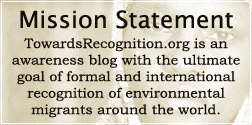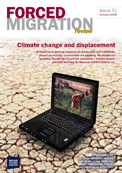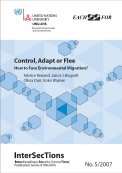Posted by Kayly Ober on April 27th, 2012 | 
(Responding to Climate Change) April 27, 2012 – While climate change and desertification can often go hand in hand, each one able to exacerbate the other, the role these two factors play in migration is starting to gain increasing prominence in research circles.
“When it comes to climate change we speak more on the impact of it on environmental degradation,” said Dina Ionesco, Policy Officer at the International Organisation for Migration (IOM). “And then it is the impacts of this environmental degradation on migration.
“We speak also on how migration has a climate change impact so we cover the full circle.”
Often referred to as ‘climate change refugees’ – although IOM steer away from this term and instead talk of ‘environmental migrants’ – once unheard of they are quickly becoming a phenomenon people are all to familiar with.
Just last month the Asian Development Bank warned that there could have been as many as 42 million environmental migrants over the last two years in Asia – as a result of extreme weather events.
And current estimates predict that by the middle of the century the world could see anywhere between 25 million and 1 billion climate related migrants.
The IOM defines environmental migrants as “persons or groups of persons who, for compelling reason of sudden or progressive change in the environment that adversely affects their lives or living conditions, are obliged to leave their habitual homes, or choose to do so, either temporarily or permanently, and who move either within their country or abroad”.
Continue reading this post »
Posted by Kayly Ober on April 18th, 2012 | 
(Center for American Progress) April 18, 2012 – Northwest Africa is crisscrossed with climate, migration, and security challenges. From Nigeria to Niger, Algeria, and Morocco, this region has long been marked by labor migration, bringing workers from sub-Saharan Africa north to the Mediterranean coastline and Europe. To make that land journey, migrants often cross through the Sahel and Sahel-Saharan region, an area facing increasing environmental threats from the effects of climate change. The rising coastal sea level, desertification, drought, and the numerous other potential effects of climate change have the potential to increase the numbers of migrants and make these routes more hazardous in the future. Added to these challenges are ongoing security risks in the region, such as Nigeria’s struggles with homegrown insurgents and the growing reach of Al Qaeda in the Islamic Maghreb, which has expanded out of Algeria.
For the United States and the international community, this region is critical because of its potential for future instability. The proximity of Algeria and Morocco to Europe, Nigeria’s emerging role as one of Africa’s most strategically important states, and Niger’s ongoing struggles with governance and poverty all demand attention. Northwest Africa’s porous borders and limited resources, which allow Al Qaeda in the Islamic Maghreb to flourish there, suggest that there is no time to waste in developing better and more effective policies for the region.
The climate, migration, and security nexus is a key test case because it is likely to exacerbate all of these existing risk factors. Climate change alone poses a daunting challenge. No matter what steps the global community takes to mitigate carbon emissions, a warmer climate is inevitable. The effects are already being felt today and are projected to intensify as climate change worsens. All of the world’s regions and nations will experience some of the effects of this transformational challenge.
Changing environmental conditions are likely to prompt human migration, adding another layer of complexity. In the 21st century the world could see substantial numbers of climate migrants—people displaced by the slow or sudden onset of climate change. While experts continue to debate the details of the causal relationship between climate change and human migration, climate change is expected to aggravate many existing migratory pressures around the world. Extreme weather events such as droughts and floods are projected to increase the number of sudden humanitarian crises in areas least able to cope, such as those already mired in poverty or prone to conflict.
Conflict and insecurity present the third layer of the nexus. This final layer is the most unpredictable, both within nations and transnationally, and will force the United States and the international community to confront climate and migration challenges within an increasingly unstructured security environment. The post-Cold War decades have seen a diffusion of national security interests and threats. U.S. security is increasingly focused on addressing nonstate actors and nontraditional sources of conflict and instability. The potential for the changing climate and associated migration to induce conflict or exacerbate existing instability is now recognized in national security circles.
This paper tracks how the overlays and intersections of climate change, migration, and security create an arc of tension in Northwest Africa comprising Nigeria, Niger, Algeria, and Morocco. These four nations, separated by the Sahara Desert, are rarely analyzed as a contiguous geopolitical region. Yet they are linked by existing international migration routes, which thread up from sub-Saharan Africa to the Mediterranean coast, moving people and cargo into Morocco, Algeria, Libya, and onward to Europe. Within the region, seasonal labor migration is widespread, particularly in areas vulnerable to rainfall fluctuations.
We seek to examine what will happen when the effects of climate change interact with internal and transnational security challenges along these well-traveled routes, and connect those questions to the strategic interests of the United States, Europe, and the transatlantic community.
Continue reading this post »
Posted by Kayly Ober on March 14th, 2012 | 
(AlertNet) March 13, 2012- Disaster-prone Asia Pacific will see a surge in climate-induced migration this century and governments need to
start planning to avoid humanitarian crises caused by millions of people fleeing their homes, a new report by the Asian Development Bank (ADB) warned Tuesday.
Migration linked to climate change, a phenomenon that will “only become more pronounced in the coming years,” poses a growing humanitarian threat, said Addressing Climate Change and Migration in Asia Pacific.
The report, available in draft form last year, also said most migration in the region would be within national boundaries, and primarily from rural to urban areas. The movement, the bulk of which will involve poor people, is likely to be influenced by social, political and economic changes as well as climate pressures.
The report urged the region’s leaders to protect migrants, improve international cooperation on migrant issues, draw up more comprehensive systems to manage disaster risks, use migration as a tool to adapt to climate change and remove barriers to insurance schemes and remittances that help
communities become more resilient.
“By taking actions today, governments can reduce the likelihood of future humanitarian crises” and maximise the possibilities that people can remain in their communities or, if they are forced to move, relocate to more secure places with livelihood options, the report noted.
“People have moved for environmental reasons since the beginning of time. What has changed lately is the policy awareness about it and also how much climate change aggravates this tendency,” said Dina Ionesco, migration policy officer for the International Organisation for Migration (IOM), at the report’s launch in Bangkok.
According to IOM, currently there are
around 200 million international migrants worldwide and over 700 million internal migrants, most of them economic migrants.
Continue reading this post »
Posted by Kayly Ober on March 8th, 2012 | 
(BBC News) March 8, 2012 – Kiribati’s President Anote Tong is in talks to buy 23 sq km (9 sq miles) on Fiji’s Vanua
Levu island.
The land is wanted for crops, to settle some Kiribati farm
ers and to extract earth for sea defences, reports say.
Some of Kiribati’s 32 coral atolls, which straddle the equator, are already disappearing beneath the ocean.
None of the atolls rises more than a few metres above the sea level.
‘Last resort’
Fiji, which is more than 2,000km (1,300 miles) away, is one of a number of countries that Kiribati hopes its population may be able to move to in the future.
The chairman of Fiji’s Real Estate Agents Licensing Board, Colin Sibary, said he was facilitating talks between Kiribati officials and a Fijian freeholder who owns the land on Vanua Levu.
“I’ve been working very hard on this for Kiribati for a year,” Mr Sibary told the BBC.
“After the purchase they will formalise a development plan which will include various farms to produce vegetables, fruit and meat for export to Kiribati.”
He said Kiribati officials also hoped to bring barges into Vanua Levu, Fiji’s second largest island, to take away landfill to help stop encroachment by the sea in Kiribati.
At most,
he thought 500 Kiribati inhabitants might end up living on Vanua Levu, involved in farming and working on the landfill project.
“There is no thought of moving them all,” he said.
President Tong said climate change was a daily battle for Kiribati, but has admitted it is one his country would ultimately lose.
He said moving the Kiribati population would be a “last resort” to save the
more than 100,000 islanders.
Relocating the entire population would be a monumental challenge, says the BBC’s Phil Mercer in Sydney.
Kiribati’s officials hope that many people would also be allowed to settle in other countries in the vast region, including Australia and New Zealand.
Previously, Mr Tong suggested constructing man-made islands resembling oil rigs for people to live on.
Source: BBC News
Posted by Kayly Ober on February 21st, 2012 | 
(Up Front Blog) February 21, 2012 – There are many uncertainties around climate change-related human mobility, particularly when it comes to potential cross
-border movements. In the first place, it is difficult to predict the number
of people who will be displaced or who will decide to migrate for reasons related to climate change. And it is difficult to determine responsibility for caring for those who are displaced across borders. There are serious normative gaps which Nina Schrepfer and I [Walter Kalin] explored in a recent paper published in UNHCR’s legal and protection policy research series.
In our paper we present the background, context and present discussions around climate change-related mobility and then identify normative gaps for each of five scenarios of population mobility likely to occur:
- In the case of sudden-onset disasters, most of those displaced will remain within their own countries as internally displaced persons (IDPs) where an existing normative framework would apply: the Guiding Principles on Internal Displacement. But some may cross international borders– for example if this is the only escape route or there are no protection and assistance capacities at home. While movement is forced, these people generally do not fall under the criteria of international refugee law.
- In the case of environmental degradation and slow-onset disasters, cross-border movements are traditionally seen as migrants moving voluntarily as a way of coping with the changing environment. But with worsening environmental degradation, the movement of persons will become increasingly involuntary. In both cases, they have no right to admission and little protection except to a limited extent under general human rights law.
- For small island states facing threats because of rising sea levels, people will have to move to other islands belonging to the same state or cross international borders. Initially they will probably be part of a migratory movement but eventually their movement will be forced. International law does not provide
sufficient protection for them.
- The effects of climate change are likely to lead to zones prohibited for human habitation and it is likely that people will be relocated to other areas within the borders of their countries. But cross-border movements could occur if proposed relocation areas are unsuitable or if no durable alternatives in line with human rights standards are offered to the affected population. The character of this cross-border movement is unclear and will probably require individual determination as to whether such acts may amount to individual persecution under refugee law.
- Finally, if the effects of climate change lead to unrest, violence and armed conflict, those fleeing across a border may qualify as refugees under the 1951 Convention and related regional instruments.
In our paper, we explore the general obligations of states at the levels of mitigation, adaptation and protection. We identify critical legal issues which remain unaddressed, including the critical question of how to distinguish between voluntary and
forced movements and suggest ways to address these gaps. Finally, we suggest that a strategy is needed to create an international regime for the protection of people crossing borders in the context of climate change which is based on the four pillars of prevention, migration management, temporary and permanent protection schemes and resettlement.
Posted by Kayly Ober on February 13th, 2012 | 
A new paper in UNHCR’s Legal and Protection Policy Research Series considers protection options for people displaced as a result of climate change. Entitled “Protecting People Crossing Bor
ders in the Context of Climate Change: Normative Gaps and Possible Approaches,” the paper looks at “normative gaps as
well
as current approaches on cross-border movements induced by the impact of climate change, and assesses possible strategies to create an effective protection regime for these people, taking account of the likelihood of a substantial increase of affected persons in the future.”
(via Forced Migration Current Awareness)
|
|



